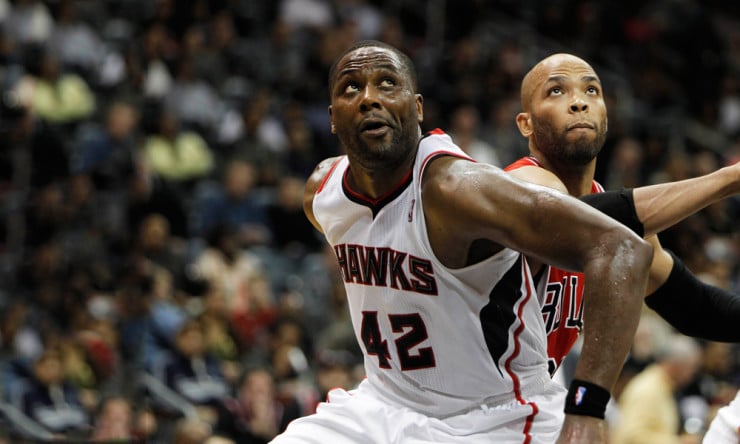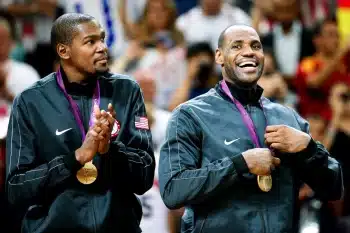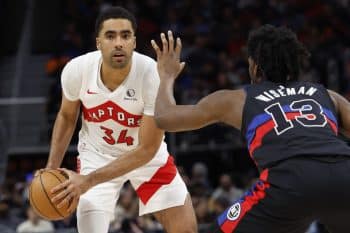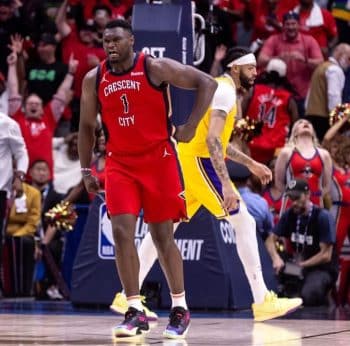NBA
NBA Saturday: Looking Back at Elton Brand’s Career

On August 8, at Peekskill High School in New York, Elton Brand announced that he is retiring from the NBA after 16 seasons. Brand, age 36, left open the possibility of returning to the NBA, but it seems likely that this is the end of the road for the power forward.
“I could get in shape if I got the call but this looks like the end of the run for me, right now it is family time,” said Brand.
Before entering the NBA, Brand spent two years at Duke University playing for Mike Krzyzewski. In the 1998-99 season, Brand earned several awards, including the Associated Press Player of the Year Award, the John R. Wooden Award and Naismith Men’s College Player of the Year.
After his second season, Brand declared for the 1999 NBA Draft and was selected first overall by the Chicago Bulls. Brand found instant success in the NBA, averaging 20.1 points, 10 rebounds, 1.9 assists and 1.6 blocks per game in his rookie season. Brand was selected to the All-Rookie First Team and named Co-Rookie of the Year with Houston Rockets guard Steve Francis. Brand had a similarly impressive second season with Chicago, but was traded to the Los Angeles Clippers in June 2001 for Brian Skinner and the draft rights to Tyson Chandler.
As he did at Duke and with the Bulls, Brand found instant individual success with the Clippers. He averaged 18.2 points, 11.6 rebounds, 2.4 assists and two blocks per game and was named an All-Star for the first time in the 2001-02 season. Brand was the first Clipper to be named to the All-Star team since Danny Manning in 1994.
Brand was the centerpiece of a young, exciting core for the Clippers that was supposed to usher in a new age of sustained success. Players like Lamar Odom, Keyon Dooling, Corey Maggette, Andre Miller, Michael Olowokandi, Quentin Richardson and Chris Wilcox were in the fold at the time, but Brand was the heart of that core.
When Brand became a restricted free agent after the 2002-03 season, former Clippers owner Donald Sterling made the unprecedented move of matching the Miami HEAT’s six-year, roughly $84 million offer for Brand (prior to this, Sterling’s biggest contractual commitment was to Eric Piatkowski on a five-year, $15 million deal).
After being retained, Brand continued his excellent play for the Clippers. He was a double-double machine, while also providing nearly 2.5 blocks per game. However, Brand had his breakout season in the 2005-06 campaign, where he averaged 24.7 points, 10 rebounds, 2.6 assists, one steal and 2.5 blocks per game, while shooting 52.7 percent from the field and 77.5 percent from the free throw line. Brand carried a scrappy Clippers team—featuring a 36 year old Sam Cassell, Cuttino Mobley, Chris Kaman, Shaun Livingston, Corey Maggette and Vladimir Radmanovic—to a 47-35 season.
The Clippers would go on to beat the Denver Nuggets in the first round (4-1) and came within a game of the Western Conference Finals, falling to the Phoenix Suns in Game 7 of the Semifinals (Clippers fans will remember this series slipping away when Raja Bell sent Game 6 into overtime with a corner three-pointer over Daniel Ewing).
In the postseason, Brand averaged an impressive 25.4 points, 10.3 rebounds, four assists and 2.6 blocks per game. Brand finished seventh in MVP voting that season and received the Joe Dumars Trophy after being named the 2005–06 NBA Sportsmanship Award winner.
Though the Clippers fell in the second round, the 2005-06 season is one that stands out in the Clippers’ less-than-impressive history. It was the Clippers’ first winning season since the 1991-92 campaign and the team’s first playoff appearance since 1997. At the center of the Clippers’ success that year was Brand, who, along with Cassell, set the tone for the team. Brand was a hardworking, non-flashy workhorse that competed on both ends of the court. Listed at 6’8 (but probably shorter than that), Brand did not have great size for a power forward. However, Brand developed a solid post-game, a sold mid-range and turnaround jumper, and had soft hands around the rim, a nose for the ball, impressive defensive instincts and long arms, which helped him block more shots than many seven-foot centers.
With Brand as the Clippers’ on-court leader, and Cassell as its vocal leader, the 2005-06 Clippers overachieved and provided fans with hope for a promising future. However, Brand regressed somewhat the following season, Cassell only played in 58 games, and Shaun Livingston suffered a gruesome knee injury in February, which effectively ended his career with the Clippers. Los Angeles’ roster became a revolving door of below league-average players, and the Clippers missed the playoffs after coming within a clutch Raja Bell three-pointer of the Western Conference Finals the year before.
The bad luck continued for Brand and the Clippers in 2007. In August of that year, during a routine workout, Brand ruptured his Achilles tendon, which required surgery and sidelined him for all but eight games that season. Brand returned from the injury to play in eight games, averaging 17.6 points, eight rebounds, two assists and 1.9 blocks per game.
After the 2007-08 season (in which the Clippers finished 23-59), Brand opted out of the final year of his contract to reportedly give the Clippers the financial flexibility to add a star player to the roster. The Clippers did just that, agreeing to terms on a five-year, $65 million deal with Baron Davis, who was coming off a strong season with the Golden State Warriors (21.8 points, 7.6 assists, 4.7 rebounds and 2.3 steals per game). Unfortunately for the Clippers, Brand decided to change course and sign with the Philadelphia 76ers on a five-year, $82 million contract.
Brand struggled throughout his tenure with the 76ers. He suffered a dislocated shoulder in December of 2008, which was operated on a few months later, ending his season. Brand ended up playing in Philadelphia for four seasons, never averaging more than 15 points, or 8.8 rebounds per game, and was eventually amnestied in 2012 to make room to sign free agent shooting guard Nick Young.
The Mavericks then claimed Brand off amnesty waivers, picking up the last year of his deal. Brand would go on to play 72 games for Dallas, providing solid on-court production and a veteran presence. After one season with the Mavericks, Brand would end up signing with the Atlanta Hawks for these last two seasons. In Atlanta, Brand took on a reserve role that limited his playing time to less than 20 minutes per game. While he was a solid locker room presence and effective post-defender, Brand never recaptured the level of consistency he had in previous seasons.
Brand played 16 seasons in the NBA and finished with career averages of 16.1 points, 8.6 rebounds, 2.1 assists and 1.7 blocks per game. While he will be remembered for being a hardworking, model teammate, we should also remember that in the first half of his career, Brand established himself as one of the best big men in the league. He was a true two-way player that helped his team as much on offense as he did on defense. Though his opponents were often bigger, stronger, flashier and more athletic, Brand often outperformed them with his unique combination of skill, intelligence and tenacity.
What is truly unfortunate is that Brand’s prime was cut short by a devastating Achilles injury, which has recently plagued other notable players like Kobe Bryant and Wesley Matthews. Brand was able to bounce back from the injury, but never fully captured his pre-injury level of production.
Though Clippers fans remain split on how to view Brand given his defection to Philadelphia, there is a compelling case that the Clippers should retire his jersey. He leads, or is close to leading most major statistical categories for the franchise and kept the team (somewhat) relevant in the mid-2000s. Though his impact on the franchise will seem less significant as the Blake Griffin-Chris Paul era Clippers continue to compete for annual playoff success, Brand should receive credit for being a constant force at a time where nothing was a constant for the Clippers. Players left, were traded, or failed to meet expectations, while coaches and executive were being hired and fired, but through it all, Brand always brought his work ethic and professionalism to the team.
Brand may eventually sign on with an NBA team for one more shot at a championship, as players often times do. However, if this is truly the end of the road for Brand, we should remember him for being a throw-back power forward that worked hard, led by example and did everything he could to help his respective teams be successful.











